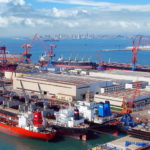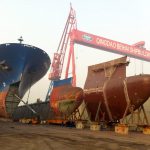One of the Chinese shipyards, which combined newbuilding, repair and conversion works in the recent shipping crises, was Qingdao Beihai. Over 50 new bulbous bows were already installed. Another segment are modifications for arctic shipping
The first shipyard in Qingdao was founded to maintain the German naval vessels of the Pacific fleet in 1898. The[ds_preview] original facilities had been in use until 2004 when the Qingdao Beihai shipyard was moving to its new facilities in Huangdao at the opposite side of the Qingdao Bay. The previous facilities had been removed to gain space for the Olympic sailing centre for the 2008 Beijing Games. Even being located further north, the weather conditions are suitable the whole year for ship repair and new building as there is no hard winter and much less rain during the summer than in south China.
On the new facilities, the shipyard under the ownership of the CSIC Group is operating a newbuilding and a ship repair facility. The total area is 3.3mill. m2 of which the shiprepair is using 400.000m2. The total investment in the yard was 1 bio. $. The ship repair branch is equipped with two graving docks of up to 405m in length and one floating dock with a length of 250m and a beam of 45m. Thus, the yard is capable of serving the biggest and most advanced vessels today. With the beginning of the shipping crises in 2008, the yard management made the decision to make the best use of the combined newbuilding and repair facilities. Being equipped with a huge steel production capacity and huge crane capacity as well as the fully equipped design offices the yard is using the capabilities and facilities of both ya rds together. So, in Qingdao the construction of the first FPSO was done in 2007.
The decision was to go for a very special, new conversion segment, the improvement of the fuel efficiency of existing vessels. This can be done by optimising the design and increasing the cargo capacity of each vessel. The yard was the first to lengthen PCTCs for major European owner in China and installing new bulbous bows for leading container shipping companies. At the first stage, several Panmax size container ships were modified.
Up to now, the yard has installed over 50 new designed bulbous bows on containerships from those first Panmax over 6,500TEU, 8,500TEU, and up to the biggest ships with 13,000 and 14,000TEU. Furthermore, Qingdao Beihai has done several projects to increase the cargo capacity by strengthening the hatchcovers, convert the lashing bridges and wheelhouse elevation. For this way of increasing the cargo capacity the whole wheelhouse is lifted with gantry cranes and new blocks are mounted before reinstallation resulting in a better view line.
With the newbuilding shipyard in house, the yard is in a position to do the design work and block building in newbuilding standards and a short time. With the yard’s big gantry cranes whole sections even of the 14,000TEU containerships can be lifted without the use of floating cranes in a very efficient manner.
Another possibility to modify existing vessels is the installation of an ice belt. This brings new possibilities to get better charter rates and use the existing ships in trades in which they could not be used before. Qingdao Beihai has recently converted three bulk carriers for use in artic waters.
Having an own in-house design team enables them to prepare complex projects in detail and do the necessary preparation for the class approval generating stability calculation and detailed design studies.
The yard is now the leading shipyard with German and international clients for the efficiency modification of dry cargo vessels in China. For 2015 Qingdao has already secured orders from several major owners for bulbous bow construction to proceed on their successful business field. Together with their German Agent Germania, the yard has already performed nearly 20 bulbous bow conversions and is preparing further projects.




















